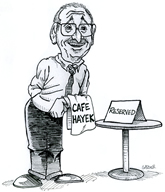The purpose of an economy is to meet the needs of consumers, since consumption is the ultimate reason why we work. Conclusions follow this truth. One is that consumers don’t have the responsibility to keep certain workers employed. The producer must serve the consumer. Should we be required to buy things that are redundant or that we don’t need or want, to keep existing businesses alive? That is the absurd logic of Cass’s inversion of the consumption-production relationship. Moreover, feeding, housing, and clothing one’s family are essential expenses. How is making these consumption expenses more expensive pro-family?
We are all consumers, and redefining the economy around manufacturing workers inevitably leads to a cronyism framework in which the government supports special interests. In serving the consumer, by contrast, we best unlock the dynamism and creativity that crowns a market economy. Consumer choices determine which products or economic actions will best locate our comparative advantage and which will not. Through this process of discovery, investors gain a better understanding of where to invest, workers learn where to work, and producers determine the resources they need to bring goods and services to the market. How does the process appear when we focus on workers and government policies that attempt to engineer wages and economic sectors, while inherently favoring some sectors over others? What knowledge is relied upon? Where does it come from? How will it be deployed? Who are the decision makers? But rather than one more Massachusetts liberal or DC economic nationalist attempting to run our lives, the better part of wisdom remains the singular standard of consumer choice and how this choice is calculated, which inherently relies on core economic concepts that will always shape economic reasoning and best conduce to an economy of plenty.
…..
We should consider another set of economic truths. Did the working class meet its demise at the hands of free trade, NAFTA, and the WTO as Cass and Roberts insist? No. As AEI economist Michael Strain and investor Clifford Asness observe: “The wages of nonsupervisory workers—roughly the bottom 80 percent of workers by pay, including manufacturing workers and service-sector workers who are not managers—have grown by around 60 percent over the past two generations. Over the past three decades, inflation-adjusted wages for typical workers have grown by 44 percent.”
Strain and Asness cite a different finding on overall wealth accumulation, observing that data from the Congressional Budget Office (CBO) notes that “families in the 51st to 90th percentiles of the wealth distribution had an average wealth of $1.3 million in 2022, the most recent year data are available. That’s up from around $500,000 in 1990, after adjusting for inflation.”
What about those with low incomes, Strain and Asness inquire? “The CBO’s income data show that inflation-adjusted post-tax-and-transfer income for the bottom 20 percent of households more than doubled from 1990 to 2021.” And “these families saw their average real wealth triple from 1990 to 2022.” Poverty rates have declined using the government’s official measure from above 20 percent in 1960 to 11 percent today. The standard is relative, so some poverty will always be found.
What about the boys down at the plant? Are we overlooking them?
In their famous paper describing the “China Shock,” David Autor, David Dorn, and Gordon Hanson observed a 13-year period from 1999 to 2011, concluding that imports from China resulted in a 21 percent decline in manufacturing employment, or a net loss of 2.4 million jobs. Numerous scholars have since questioned these findings of such job losses, reducing the number by half or even more. We should note the number of jobs created in America by imports, which economists also point to in evaluating China Shock. I don’t diminish job losses or the psychological toll they exert. It is a natural part of any freely functioning economy, however, and an inherent aspect of capitalism and America’s economic history. Six million jobs were also created during this same period in other sectors of the economy. Economist Jeremy Horpedahl has recently tested the jobs and incomes of the 10 cities most negatively affected by the China Shock. His findings indicate that most of them currently boast more jobs than they did in 2001. Moreover, these same cities have higher real wages for workers at every income level. Amidst the current push for reindustrializing America, we might wonder who will fill the already 450,000 open manufacturing jobs? Declinist narrative and DC opportunity mill meet economic reality.
This summer marks three years since the United States embarked on a new and massive industrial policy experiment, with President Joe Biden signing the CHIPS Act and Inflation Reduction Act in July and August 2022, respectively. Capitolism has repeatedly expressed concerns about those laws, based on both U.S. industrial policy’s long history of challenges and snippets indicating that the same old problems are reemerging once again. You might recall, in particular, that I’ve been skeptical of the widely touted increase in U.S. manufacturing construction spending, not because it was fake (though inflation surely has tempered the spending’s real dollar-value) but because we simply didn’t yet know what all those dollars were getting us. Now that we’re at three years, however, the picture is becoming clearer—as are some of the industrial policies’ large and unseen costs.
The obvious place to start is with still-struggling Intel. The recipient of the CHIPS Act’s largest grant (along with billions more in tax credits) confirmed last week that it will again delay completion of the first phase of its Ohio mega-complex to at least 2030 or 2031. As you may recall, Intel’s now-“retired” CEO announced the Ohio project in 2022 as part of the company’s rather blatant push to get the CHIPS Act passed, promising the complex would be operational this year. Now, however, the Ohio facility’s future is in doubt, as Intel’s new CEO is cutting back on capital expenditures—he believes the previous management overinvested (gee, I wonder why?)—and recently suggested the company might abandon advanced chipmaking altogether. Some analysts also believe that Intel should abandon chip manufacturing to focus on other core businesses, but—given the company’s domestic manufacturing footprint and political importance—they’re skeptical that the U.S. government would let that happen.
This is not, to put it mildly, a great situation.
Of course, not all CHIPS Act headliners are doing as badly as Intel, but others’ U.S. projects also raise concerns. Industry leader TSMC, for example, is now producing some advanced semiconductors in Arizona, but—as National Review’s Dominic Pino reported last October—that facility wasn’t spurred by CHIPS money. We’ve discussed, moreover, that the Arizona factory’s current output is less advanced than its best Taiwan-made chips, relatively small, and relatively costly. TSMC doubled down on that last point in April when it hiked U.S. prices substantially, and the most recent figures put its Arizona-made chips at 5 to 20 percent pricier than those from Taiwan. More and better U.S.-made chips are coming from TSMC, but—as Treasury Secretary Scott Bessent just lamented—the fully operational Arizona factories will satisfy just 7 percent of U.S. demand and are also being further delayed by high costs and red tape. (And they’re still being flown to Taiwan for packaging—at least for now.)
Speaking of red tape and delays, Micron’s huge memory chip facility in upstate New York hasn’t even broken ground yet and won’t do so until at least late November, thanks in large part to state and federal environmental regulations and other CHIPS Act requirements (including social policy ones). Given that Micron still “needs to obtain dozens of permits, from the federal Environmental Protection Agency to the town of Clay,” even this new timeline appears optimistic. Regardless, the current best case is that Micron’s first factory won’t come online until 2029 and its entire complex won’t be cranking until 2045. (Anyone wanna bet?) And analysts doubt that the struggling firm’s New York output will be “cost competitive.”
Other subsidized New York semiconductor facilities, it should be noted, are suffering similar delays.
As one judge told Mr. [Brett] Shumate, it seems “you’re asking for unbounded authority” to impose tariffs. Yes he is. But as the small business plaintiffs argue, the President isn’t a king, and the Constitution doesn’t let him command the trade tides.
Moreover, he warned against the temptation to overstate the need for gradual liberalization. Manufacturers would tend to overstate their reliance on protection, and labor markets were quite flexible and could rapidly adapt to shocks. For example, after a war, soldiers and sailors rush back into the labor market, which handles those situations well. Smith expected that the same would be true with labor-market churn after sudden liberalization.
Smith is a well-known defender of free trade, which is why his exceptions might garner significant attention. That attention should be tempered by the recognition that Smith did not see them as blank checks for policymakers. It would serve us well to heed his warnings.
It couldn’t come soon enough. What’s become obvious in recent years—thanks to the taste of it we got with the Biden administration—is that climate hysteria is one of the greatest threats to freedom in modern times. The more cynical of its promoters seized on it for that reason—as a justification for total power. If day-to-day human activity is causing the Earth to melt, government must control the day-to-day: what we drive, what we eat, what products we buy, what industries exist (and don’t), where we live. Anyone who disagrees with the regime’s reigning narrative—the collective requirement to address the “existential” threat—is branded the climate version of an “enemy of the people”: a “denier.” It’s corrosive.
The right this week debuted its new strategy, and Americans received the bigger scientific picture. Long may that healthy, vigorous debate—the essence of good science—continue.
They [these leftists] seem to want a regression to the Dark Ages: an unsophisticated economy with no landlords, no insurers, no complex markets. They see complexity in the economy, the reason for which is beyond their comprehension, as parasitic.



